Abstract
The effect of growth temperature on the virulence of a strain of broth-grown serogroup 1 Legionella pneumophila (Wadsworth F889) was examined by growing the bacterium at different temperatures and then infecting guinea pigs (by intratracheal injection) and guinea pig alveolar macrophages. The 50% lethal dose for guinea pigs infected with 25 degrees C-grown F889 was log10 5.0 CFU and that for 41 degrees C-grown F889 was log10 5.7 CFU, or a fivefold difference. Guinea pig alveolar macrophages were infected in quadruplicate with log10 3.8 CFU of F889 cells grown at either 25 or 41 degrees C. Counts of F889 in the alveolar macrophages infected with 25 degrees C-grown bacteria were 40% greater after 1 day of incubation (P = 2 X 10(-4)) than were counts in the alveolar macrophage suspensions inoculated with 41 degrees C-grown bacteria. However, the counts were not significantly different after 3 days of incubation. Examination of cover slip cultures of guinea pig alveolar macrophages infected with 25 degrees C-grown or 41 degrees C-grown bacteria showed that the bacteria grown at the lower temperature were twice as likely to be macrophage-associated after 1 h of incubation than were the bacteria grown at the higher temperature. Growth at the lower temperature was also associated with a change in reactivity with monoclonal antibodies, but not with a change in plasmid content. Thus, environmental temperature may play an important role in modulating the virulence of L. pneumophila, possibly by affecting bacterial adherence to host cells.
Full text
PDF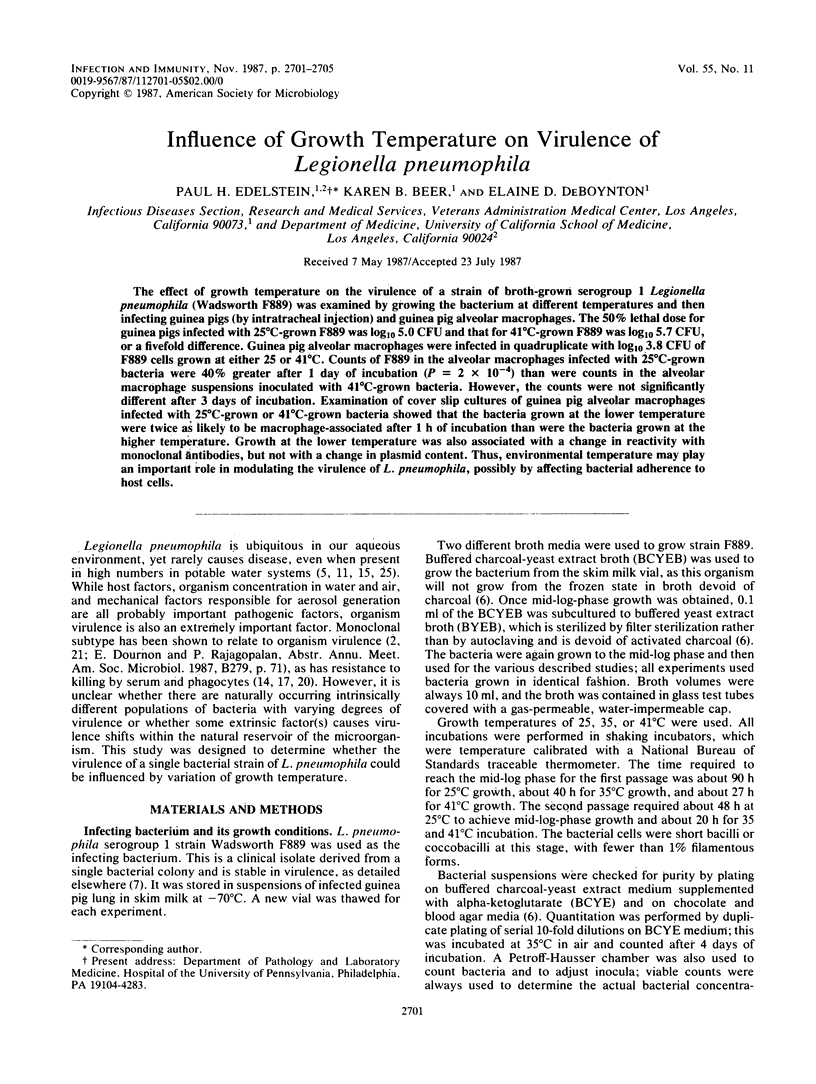
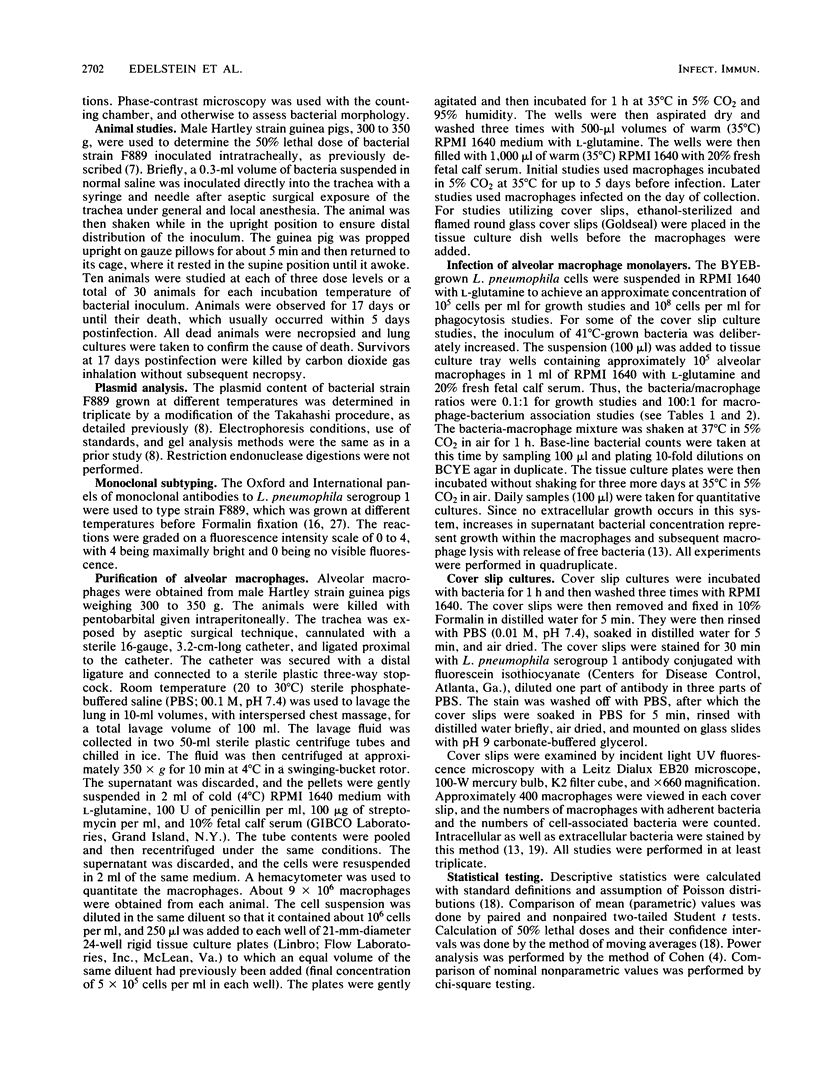
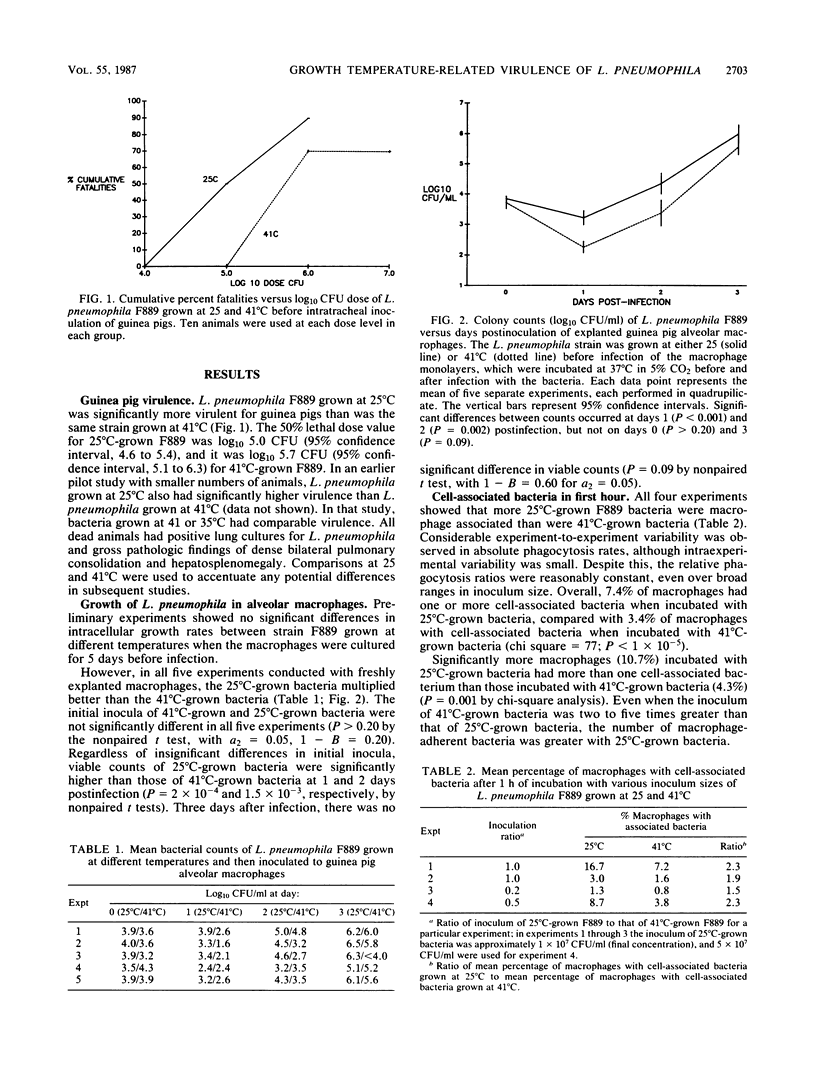
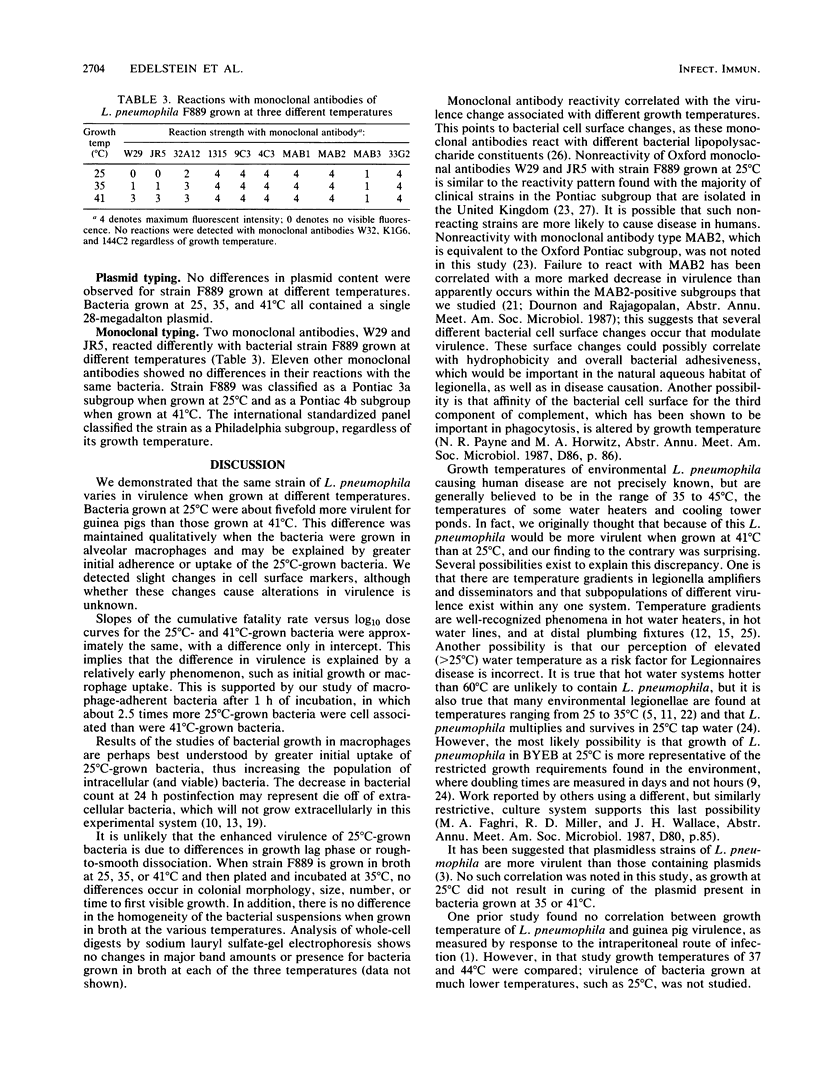
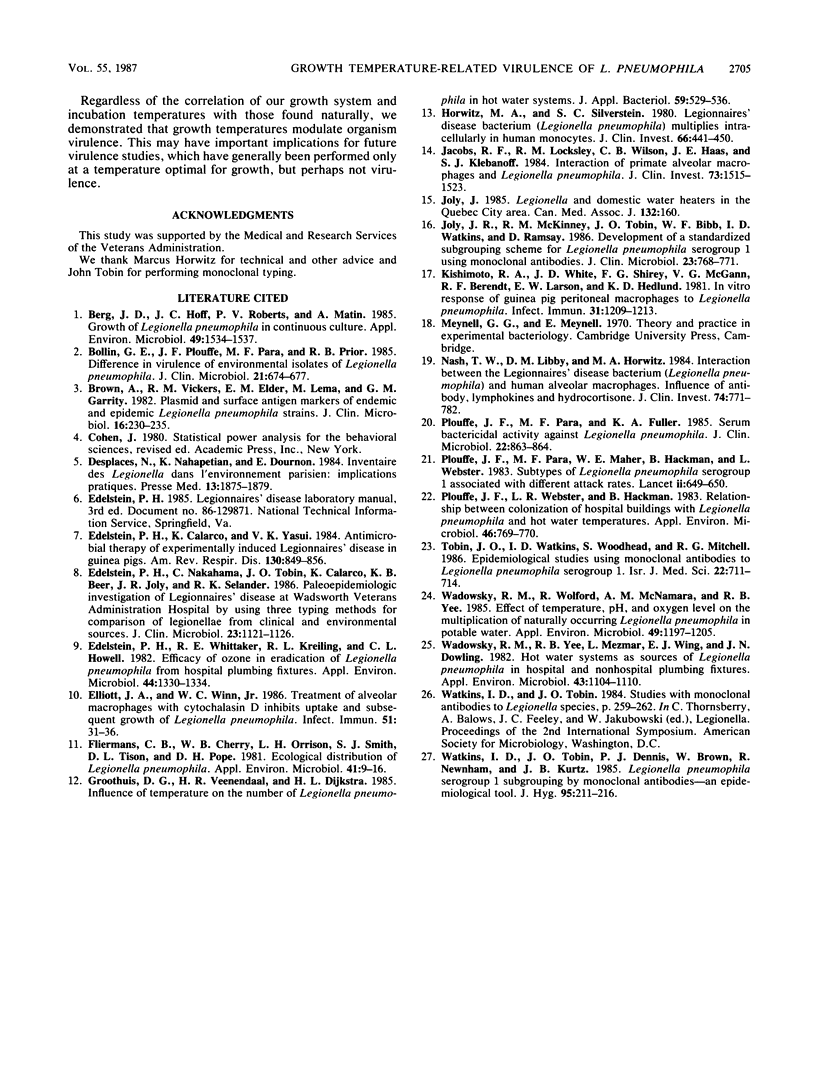
Selected References
These references are in PubMed. This may not be the complete list of references from this article.
- Berg J. D., Hoff J. C., Roberts P. V., Matin A. Growth of Legionella pneumophila in continuous culture. Appl Environ Microbiol. 1985 Jun;49(6):1534–1537. doi: 10.1128/aem.49.6.1534-1537.1985. [DOI] [PMC free article] [PubMed] [Google Scholar]
- Bollin G. E., Plouffe J. F., Para M. F., Prior R. B. Difference in virulence of environmental isolates of Legionella pneumophila. J Clin Microbiol. 1985 May;21(5):674–677. doi: 10.1128/jcm.21.5.674-677.1985. [DOI] [PMC free article] [PubMed] [Google Scholar]
- Brown A., Vickers R. M., Elder E. M., Lema M., Garrity G. M. Plasmid and surface antigen markers of endemic and epidemic Legionella pneumophila strains. J Clin Microbiol. 1982 Aug;16(2):230–235. doi: 10.1128/jcm.16.2.230-235.1982. [DOI] [PMC free article] [PubMed] [Google Scholar]
- Desplaces N., Nahapetian K., Dournon E. Inventaire des Legionella dans l'environnement parisien. Implications pratiques. Presse Med. 1984 Sep 15;13(31):1875–1879. [PubMed] [Google Scholar]
- Edelstein P. H., Calarco K., Yasui V. K. Antimicrobial therapy of experimentally induced Legionnaires' disease in guinea pigs. Am Rev Respir Dis. 1984 Nov;130(5):849–856. doi: 10.1164/arrd.1984.130.5.849. [DOI] [PubMed] [Google Scholar]
- Edelstein P. H., Nakahama C., Tobin J. O., Calarco K., Beer K. B., Joly J. R., Selander R. K. Paleoepidemiologic investigation of Legionnaires disease at Wadsworth Veterans Administration Hospital by using three typing methods for comparison of legionellae from clinical and environmental sources. J Clin Microbiol. 1986 Jun;23(6):1121–1126. doi: 10.1128/jcm.23.6.1121-1126.1986. [DOI] [PMC free article] [PubMed] [Google Scholar]
- Edelstein P. H., Whittaker R. E., Kreiling R. L., Howell C. L. Efficacy of ozone in eradication of Legionella pneumophila from hospital plumbing fixtures. Appl Environ Microbiol. 1982 Dec;44(6):1330–1333. doi: 10.1128/aem.44.6.1330-1333.1982. [DOI] [PMC free article] [PubMed] [Google Scholar]
- Elliott J. A., Winn W. C., Jr Treatment of alveolar macrophages with cytochalasin D inhibits uptake and subsequent growth of Legionella pneumophila. Infect Immun. 1986 Jan;51(1):31–36. doi: 10.1128/iai.51.1.31-36.1986. [DOI] [PMC free article] [PubMed] [Google Scholar]
- Fliermans C. B., Cherry W. B., Orrison L. H., Smith S. J., Tison D. L., Pope D. H. Ecological distribution of Legionella pneumophila. Appl Environ Microbiol. 1981 Jan;41(1):9–16. doi: 10.1128/aem.41.1.9-16.1981. [DOI] [PMC free article] [PubMed] [Google Scholar]
- Groothuis D. G., Veenendaal H. R., Dijkstra H. L. Influence of temperature on the number of Legionella pneumophila in hot water systems. J Appl Bacteriol. 1985 Dec;59(6):529–536. doi: 10.1111/j.1365-2672.1985.tb03356.x. [DOI] [PubMed] [Google Scholar]
- Horwitz M. A., Silverstein S. C. Legionnaires' disease bacterium (Legionella pneumophila) multiples intracellularly in human monocytes. J Clin Invest. 1980 Sep;66(3):441–450. doi: 10.1172/JCI109874. [DOI] [PMC free article] [PubMed] [Google Scholar]
- Jacobs R. F., Locksley R. M., Wilson C. B., Haas J. E., Klebanoff S. J. Interaction of primate alveolar macrophages and Legionella pneumophila. J Clin Invest. 1984 Jun;73(6):1515–1523. doi: 10.1172/JCI111357. [DOI] [PMC free article] [PubMed] [Google Scholar]
- Joly J. R., McKinney R. M., Tobin J. O., Bibb W. F., Watkins I. D., Ramsay D. Development of a standardized subgrouping scheme for Legionella pneumophila serogroup 1 using monoclonal antibodies. J Clin Microbiol. 1986 Apr;23(4):768–771. doi: 10.1128/jcm.23.4.768-771.1986. [DOI] [PMC free article] [PubMed] [Google Scholar]
- Joly J. Legionella and domestic water heaters in the Quebec City area. Can Med Assoc J. 1985 Jan 15;132(2):160–160. [PMC free article] [PubMed] [Google Scholar]
- Kishimoto R. A., White J. D., Shirey F. G., McGann V. G., Berendt R. F., Larson E. W., Hedlund K. W. In vitro responses of guinea pig peritoneal macrophages to Legionella pneumophila. Infect Immun. 1981 Mar;31(3):1209–1213. doi: 10.1128/iai.31.3.1209-1213.1981. [DOI] [PMC free article] [PubMed] [Google Scholar]
- Nash T. W., Libby D. M., Horwitz M. A. Interaction between the legionnaires' disease bacterium (Legionella pneumophila) and human alveolar macrophages. Influence of antibody, lymphokines, and hydrocortisone. J Clin Invest. 1984 Sep;74(3):771–782. doi: 10.1172/JCI111493. [DOI] [PMC free article] [PubMed] [Google Scholar]
- Plouffe J. F., Para M. F., Fuller K. A. Serum bactericidal activity against Legionella pneumophila. J Clin Microbiol. 1985 Nov;22(5):863–864. doi: 10.1128/jcm.22.5.863-864.1985. [DOI] [PMC free article] [PubMed] [Google Scholar]
- Plouffe J. F., Para M. F., Maher W. E., Hackman B., Webster L. Subtypes of Legionella pneumophila serogroup 1 associated with different attack rates. Lancet. 1983 Sep 17;2(8351):649–650. doi: 10.1016/s0140-6736(83)92531-x. [DOI] [PubMed] [Google Scholar]
- Plouffe J. F., Webster L. R., Hackman B. Relationship between colonization of hospital building with Legionella pneumophila and hot water temperatures. Appl Environ Microbiol. 1983 Sep;46(3):769–770. doi: 10.1128/aem.46.3.769-770.1983. [DOI] [PMC free article] [PubMed] [Google Scholar]
- Tobin J. O., Watkins I. D., Woodhead S., Mitchell R. G. Epidemiological studies using monoclonal antibodies to Legionella pneumophila serogroup 1. Isr J Med Sci. 1986 Oct;22(10):711–714. [PubMed] [Google Scholar]
- Wadowsky R. M., Wolford R., McNamara A. M., Yee R. B. Effect of temperature, pH, and oxygen level on the multiplication of naturally occurring Legionella pneumophila in potable water. Appl Environ Microbiol. 1985 May;49(5):1197–1205. doi: 10.1128/aem.49.5.1197-1205.1985. [DOI] [PMC free article] [PubMed] [Google Scholar]
- Wadowsky R. M., Yee R. B., Mezmar L., Wing E. J., Dowling J. N. Hot water systems as sources of Legionella pneumophila in hospital and nonhospital plumbing fixtures. Appl Environ Microbiol. 1982 May;43(5):1104–1110. doi: 10.1128/aem.43.5.1104-1110.1982. [DOI] [PMC free article] [PubMed] [Google Scholar]
- Watkins I. D., Tobin J. O., Dennis P. J., Brown W., Newnham R., Kurtz J. B. Legionella pneumophila serogroup 1 subgrouping by monoclonal antibodies--an epidemiological tool. J Hyg (Lond) 1985 Oct;95(2):211–216. doi: 10.1017/s0022172400062641. [DOI] [PMC free article] [PubMed] [Google Scholar]


